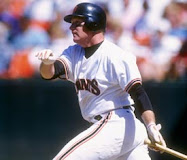Last night fit that bill perfectly, as Bumgarner went six innings, and struck out eight Dodger hitters, while only allowing four hits, two walks, and a run on 114 pitches. It was classic Bumgarner, what Giants fans have been used to for about a decade: not exactly the prettiest, not perfect, but still solid when it mattered most. And as usual, Bumgarner did it on the big stage, against Giants fans’ most hated opponent at Oracle Park.
Bumgarner didn’t get the win (per usual this year, the offense couldn’t back up the Giants’ stellar pitching), but it was a nice showcase for the 29-year-old ace, who showed that despite injury issues the past couple of years, he can still bring it and compete at the highest level. And while that is nice for Giants fans who may still hold onto the glimmer of hope that the organization can still stay in the playoff race (after all…we’ve only been a month into the season), it is more relevant to other organizations in baseball: Bumgarner is available, he is in the last year of his deal, and he can still perform against the best teams in baseball.
As he walked off the mound after finishing the sixth inning, you could sense that this performance may be the beginning of the end for MadBum in the black and orange. With pitching a premium around the league, and more crucial than ever for playoff qualification as well as success, there are not many pitchers on the market who are as affordable and reputable as Bumgarner. And for the Giants, with a terrible offense, an aging roster, and a thin farm system, getting some kind of return to booster this organization from the bottom up is more important than ever for new head honcho Farhan Zaidi, who was hired as Bobby Evans’ replacement to breathe new life in San Francisco. It won’t be a matter of “if” Bumgarner will be traded…more like a matter of “when.”
And it’s bittersweet because Bumgarner has been one of the best Giants pitchers…well…ever.
After Barry Bonds’ “retirement” in 2007, the Giants put a premium on developing the pitching, which never was “great” during Bonds’ tenure in the Bay Area (unless you consider Livan Hernandez and Shawn Estes “great”). The “swing for the fences” approach provided some fireworks and storylines during the Bonds era, but often it failed to lead to much significant or consistent regular season and postseason success. Then general manager at the time, Brian Sabean, shifted the Giants’ focus from offense (relying on aging power vets like Bonds and Moises Alou, for example, failed to get the Giants a World Series title) to pitching and defense (to prevent runs in Oracle Park’s spacious outfield) and can be credited for developing a home-grown rotation and plucky, on the cheap bullpen that set up their three-World-Series run from 2010–2014.
The shift in organizational approach started with Matt Cain, who went 13–12 as a rookie in 2005, and ended up being a workhorse for the Giants for nearly a decade en route to three All-Star appearances (2009, 2011, 2012). Then “The Freak” Tim Lincecum joined him, earning back-to-back Cy Young awards in 2008 and 2009 while helping the Giants go from cellar-dweller to playoff contender. And while those two aces certainly experienced incredible high’s as Giants, it wasn’t until Bumgarner came along in 2010 (he debuted in 2009, but his first full season wasn’t until 2010) that the rotation really solidified and the Giants became the NL West juggernaut that they were from 2010–2016.
While Cain and Lincecum had more regular season brass and accolades (the highest Bumgarner ever finished in the Cy Young standings was fourth in 2014 and 2016), no other pitcher in the Giants organization was more valuable. From 2011–2016, Bumgarner was the ninth most valuable pitcher in baseball, according to WAR. Take a look at the chart below, and you can see that Bumgarner, though he has not won a Cy Young in his career, is up there statistically with past Cy Young winners such as the Dodgers’ Clayton Kershaw, Nationals’ Max Scherzer, and Mariners’ Felix Hernandez, just to name a few.
Since 2016, it has been a rougher patch for Bumgarner, as injuries limited him to only 40 starts and 240 innings in 2017 and 2018 combined (he had no fewer than 32 starts and 204 innings every season from 2011 to 2016). Of course, he’s not alone in the Giants rotation when it comes to problems: big free agent pickup Johnny Cueto has also struggled to stay healthy (he missed most of last year due to arm issues, and will miss most, if not all, of this year due to Tommy John surgery), and Jeff Samardzija has struggled with inconsistency (15 losses in 2017; a 5.44 FIP in 2018). But despite the health question marks, Bumgarner still flashes that 2011–2016 self more often than not: he had a 3.32 and 3.26 ERA in 2017 and 2018, respectively, and though his ERA is higher in 2019 than the previous two years (3.92), his FIP is actually better (3.26), a reverse from the previous two seasons where his FIP (3.99 and 3.95, respectively) was higher than his ERA the past two seasons. If Bumgarner continues to pitch like last night, it will only be a matter of time before his ERA regresses closer to his career average (3.06).
But then again, Bumgarner probably won’t be around long enough in San Francisco for Giants fans to see it get there this season.












